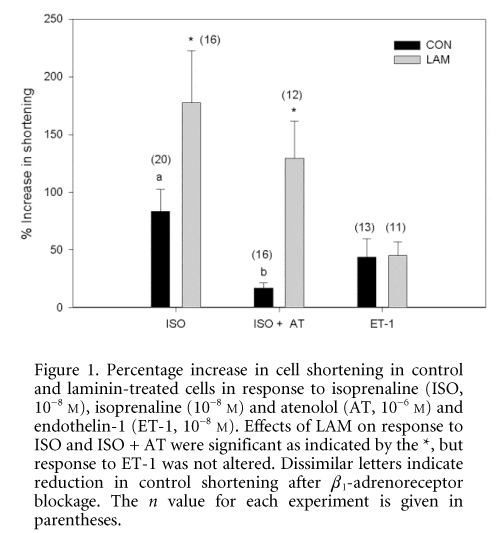Binding of the extracellular matrix protein laminin to integrin receptors may modulate intracellular signalling pathways in the heart. We were interested in the effect of laminin on the contractile response of single ventricular myocytes to β-adrenergic and endothelin-1 (ET-1) stimulation.
Male Wistar rats were killed by Schedule 1 procedures. Single ventricular myocytes were isolated by enzymatic digestion and then placed on glass coverslips either in the absence (CON) or presence (LAM) of laminin (final concentration 10 mg ml-1). After at least 2 h of incubation, coverslips were placed in a superfused experimental chamber on an inverted microscope and cell shortening was measured by video edge detection during field stimulation at 0.5 Hz (22-24 °C).
The non-selective β-adrenoreceptor agonist isoprenaline (10-8 M) caused a greater increase in shortening in LAM than CON cells (P < 0.05, Student’s unpaired t test). When β1-adrenoreceptors were antagonised with 10-6 M atenolol, the response to isoprenaline was not different in LAM cells, but almost abolished in CON cells (P < 0.05; denoted by dissimilar letters in Fig. 1). By contrast, laminin binding had no significant effect on the inotropic response to 10-7, 10-8 or 10-9 M ET-1 (P > 0.05; Fig. 1, only data for 10-8 M shown).
The effect of laminin on the contractile response to β-adrenergic stimulation in rat ventricular myocytes is consistent with the response of the L-type Ca2+ current seen in cat atrial myocytes (Wang et al. 2000). This suggests a common mechanism in myocardium that may involve the depression of β1-adrenergic pathway and stimulation of the β2-adrenergic pathway. Given the lack of effect of laminin on the response to ET-1, it appears that the impact of laminin is specific for certain signalling pathways.
This work was supported by the University of Leeds (S.S.A.), the British Heart Foundation (S.C.C.) and the National Science and Engineering Research Council of Canada (H.A.S.).
All procedures accord with current UK legislation.

